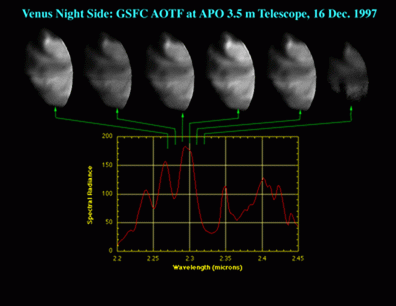
The GSFC acousto-optic tunable filter (AOTF) camera was used at the Apache Point Observatory 3.5 meter telescope in Sunspot, NM, to image the night side of Venus.
In the near-infrared, there are several spectral regions that are relatively clear in the Venus atmosphere. At these wavelengths, radiation from the Venus night side is actually thermal emission from the lower atmosphere that escapes through low-opacity regions of the sulfuric acid cloud deck.
By imaging the Venus night side, an AOTF camera can determine spatial variations of trace molecular species in the Venusian atmosphere, and even study the dynamics of the zonal winds on Venus. The spectral resolution of the AOTF camera (R ~ 200-400) is several times higher than that of traditional narrow-band or circular-variable filters, which makes it possible to selectively image in and out of molecular absorption bands. Electronic tuning allows programmable access to any wavelength within a ~ 1 octave tuning range.
This figure shows a low-resolution spectrum (Pollack et al. 1993) of the Venus night side, illustrating the 2.3 micron spectral window. Above the spectrum are sample AOTF images, at wavelengths designated by the arrows leading from the spectrum to the individual images. The AOTF camera was tuned in steps of 18 cm-1 in this spectral region, resulting in a cube of 30 images that contains both spatial and spectral information. A similar, 12-image cube (not shown) was made at 1.74 microns, in another spectral window of the Venus atmosphere.
The night side images are oriented so that the planet's limb is to the left, and north is up. The outline of the circular aperture of the instrument is seen on the right side of each image. The illuminated crescent of Venus, which is roughly 1000 times brighter than the night side, was placed well outside of the field of view to avoid scattered light contamination in the instrument.
The images were taken on 16 December 1997 between 00:30-00:35 UT. The observers were Nancy Chanover (NRC/GSFC), Chris Gelino (NMSU), Dave Glenar (GSFC/Code 693), and John Hillman (GSFC/Code 690).
Special thanks to: Mark Marley (NMSU), Denise Stephens (NMSU), Dave Robinson (NASA/GSFC), Charles Corson (APO) and the rest of the APO staff.